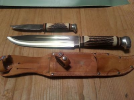- Joined
- Jan 12, 2009
- Messages
- 3,198
Well, from a hunting standpoint the design did have a purpose since the Loveless knives that featured it were mainly designed for big game processing.The tip section of the knife was ground thinner for better skinning proficiency but the grind at the rear was left thicker so it could handle splitting through animals pelvic bones and joints without suffering damage or breaking. Many of these design requirements seem to come from some idea of necessity which may hold true in that case but I don’t see the need for it on a tactical folding knife.
These knives were about 12" overall and had about a 7 - 8" blade. They all seem to have large, thick spines and deep fullers. As you described about using the knife as a hunting tool, that is exactly how those guys (including my own grandfather) used them. My grandfather had a large knife as described above that was part of a set that had a much smaller knife with a large belly in it for skinning. He was doing that "two edges on the same knife" back in the early 50s. Not sure why a differential sharpening technique derived for practical use would generate an opinion that it was from someone that didn't cut anything.
While grandpa was careful with the 2/3 of the blade towards the point that was actually pretty sharp, he used the 1/3 back towards the handle to cut up small sticks, etc., for a fire as well as his animal processing. The first third towards the handle was his "mini chopper". IIRC, he also used that knife to cut the feet off of the ducks he shot when cleaning them up.





